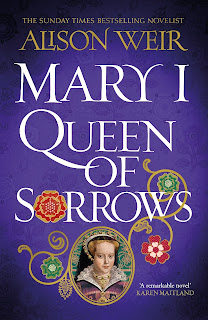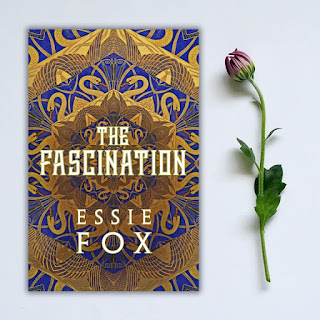Featured
- Get link
- X
- Other Apps
Mary 1 Queen of Sorrows by Alison Weir #Review
Today it is a real honour to be taking part in the celebrations for Alison Weir's latest historical novel, Mary 1 Queen of Sorrows which was published on May 9th by Headline Review.
A DESTINY REWRITTEN. A ROYAL HEART DIVIDED.
Adored only child of Henry VIII and his Queen, Katherine of Aragon, Princess Mary is raised in the golden splendour of her father’s court. But the King wants a son and heir.
With her parents’ marriage, and England, in crisis, Mary’s perfect world begins to fall apart. Exiled from the court and her beloved mother, she seeks solace in her faith, praying for her father to bring her home. But when the King does promise to restore her to favour, his love comes with a condition.
The choice Mary faces will haunt her for years to come – in her allegiances, her marriage and her own fight for the crown.
Can she become the queen she was born to be?
MARY I. HER STORY.
Alison Weir’s new Tudor novel is the tale, full of drama and tragedy, of how a princess with such promise, loved by all who knew her, became the infamous Bloody Mary.
BLOODY MARY?
Alison Weir’s personal take on Mary I.
When Headline commissioned my Tudor Rose trilogy of novels, I was gripped by the prospect of writing the final book in the trilogy, Mary I: Queen of Sorrows. I had already covered her reign in my non-fiction work Children of England: The Heirs of Henry VIII, which was published in 1996 and focused on Henry’s three successors, Edward VI, Mary I and Elizabeth I, and his niece, Lady Jane Grey. Having undertaken extensive research, I was very familiar with Mary’s story and her later notoriety as ‘Bloody Mary’.
But there was a personal reason for my enthusiasm too. I have enormous sympathy for Mary as the child of a broken marriage and, later, a woman fighting for the right to practise her religion. She was eleven when her parents’ marriage started to fall apart; I was eleven when mine split up. In each case, there was another woman involved, whom I loathed as much as Mary loathed Anne Boleyn. In each case, the break-up was complicated and painfully drawn out. My father did not spare me the emotional traumas from which he should have protected me, and the same could be said of Henry VIII’s treatment of Mary. My mother was as staunchly loving and supportive of me as Katherine of Aragon was of Mary. Like Katherine, she was threatened with prison if she defied my father. I understand Mary’s nervous reactions, for I reacted in a similar way, having suffered life-long anxiety as a consequence of what my father did, and I too frequently hark back to the safe, happy world of my childhood, which seems like a golden age in retrospect, as Mary’s must have done to her.
My own experiences therefore inform this book. I am well placed to understand how the ‘Great Matter’ of the ‘Divorce’ impacted on Mary. I would not now define myself as a victim, but that was nevertheless what I was – and what Mary was. And both of us, I feel, eventually rose above it.
Since I published Children of England, much new research has been done on Mary, and new biographies have been published, focusing on her achievements. In recent years, I have become aware that there has been a concerted attempt to rehabilitate her reputation. Yet when I came to write this novel, and revisited my own research, I found that I could not entirely support this new view. Yes, it is important to credit Mary for her achievements, the greatest of which was her successful taking of the throne that was rightfully hers. No one could doubt her courage or her presence of mind. Against tremendous odds, she overcame an attempt to replace her with her cousin, Lady Jane Grey, and emerged triumphant, to a roar of popular acclaim.
But there, with her accession, my sympathy for Mary begins to evaporate. As a novelist, it was a challenge to make her a wholly sympathetic heroine, because I find it impossible to see her that way. I have tried tolook at things from her point of view, but I cannot go against what the historical evidence is telling me – and this book is based closely on the historical record. And so this novel offers what I hope is a balanced – if controversial – portrayal.
PRAISE FOR ALISON WEIR’S TUDOR FICTION
‘History has the best stories and they should all be told like this’ Conn Iggulden
‘As always, Alison Weir is ahead of the curve - and at the top of her game’ Sarah Gristwood
‘Weir is excellent on the little details that bring a world to life’ Guardian
‘Profoundly moving... lingers long after the last page’ Elizabeth Fremantle
My Thoughts
This is a fascinating read and one which any lover of this period of history will savour. It is meticulously researched but what is most impressive is the author’s ability to breathe life into the historical facts and present you with some believable characters. Mary stands out from the page, as a living, breathing person and it is so interesting to see how she copes with events as she sees some terrifying things happen to people she knows.
Danger is never far away in the Tudor court and you are aware that as Mary observes terrible events happening to her Mother, Katherine. of Aragon, she is absorbing lessons about marriage and relationships which will affect her forever. She learns quite early never to show fear or weakness. Despite the length and depth of the story, this is an accessible read which broadens your understanding of the times. Mary is hard to like at tines, but her anguish as she longs to be a mother reveals a vulnerability which her actions as Queen do not. Her relationships with her siblings are complex. In many ways they are rivals but Mary’s strong Catholic belief seems to be her overriding motivation and vision for England.
In short: captivating history
About the Author
Alison Weir is a bestselling historical novelist of Tudor fiction, and the leading female historian in the United Kingdom. She has published more than thirty books, including many leading works of non-fiction, and has sold over three million copies worldwide.
Her novels include the Tudor Rose trilogy, which spans three generations of history’s most iconic family - the Tudors, and the highly acclaimed Six Tudor Queens series about the wives of Henry VIII, all of which were Sunday Times bestsellers.
Alison is a fellow of the Royal Society of Arts and an honorary life patron of Historic Royal Palaces.
You can follow Alison here: X (Twitter) | | Website
Book link: Amazon UK
Thanks to Alison Weir, Headline Review and Anne Cater of Random Things Tours for a copy of the book and a place on the tour.
Check out the rest of the tour!
- Get link
- X
- Other Apps
Popular Posts
Bear Grylls Adventures - 12 book set #Review
- Get link
- X
- Other Apps
The Perfect Match by Dandy Smith #Review
- Get link
- X
- Other Apps
The Fascination by Essie Fox #Review #Repost #Giveaway
- Get link
- X
- Other Apps








Comments
Post a Comment